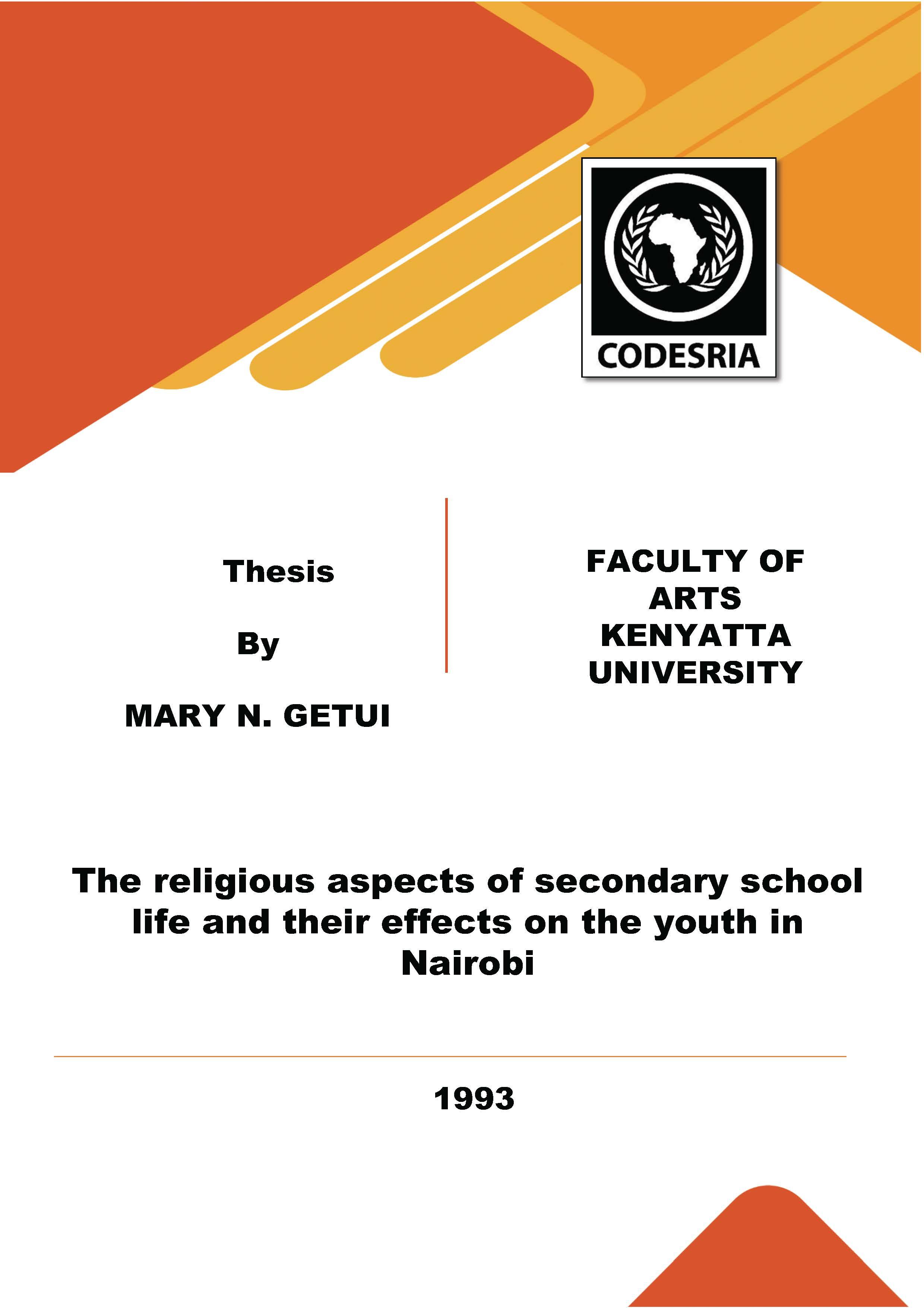The religious aspects of secondary school life and their effects on the youth in Nairobi
Keywords:
Secondary schools, religion, youth, social implications, religious aspects, KenyaSynopsis
The world is a "mixed-grill" so to say. It is made of people with varied set ups- geographical, racial, cultural, etc. Each specific community or country's way of life is mainly determined by what the local situation has to offer and the approach taken by the people to fit in. Further still, each persan is expected to play their role in order to survive and to contribute towards the group's sustainance. For this need to be met and to be effective, it has been deemed necessary and important that a system of training through education be adopted to guide the individuals and society on what is expected of them and how to go about fulfilling it. This explains the different for ms and types of education offered the world overinformal, formai, non-formai. Whatever the form/type of education offered, it should be a diversified and all-round entity meeting the physical, mental, moral and spiritual needs of the learner. The emphasis of this thesis is on whether and how the spiritual aspects of the secondary school students are met, and the effects there-of. The area of concentration is Nairobi where 33 sample schools are studied, with a "peep" being taken in 2 peri-urban schools in Kiambu District and 4 rural based schools in Kisii District for comparison purposes. Kenyatta University is used to determine the long-term and post effects of religious aspects of secondary school life. In order to understand the category of people focused on the characteristics and problems faced by the students are looked at and these are found to be determined and linked to their stage of ·development as well as the home, school, and social set-up. It is also recognised that society has high expectations of and for this category of people. The study is concerned about the informai spiritual aspects of school life consequently the general co-curricular activities in the specified institutions are looked at. Those with a religious bias are then concentrated on. The role of the informai activities and the students opinions and attitudes towards these activities have been identified as well as the motivating factors and benefits derived from participating in them.
This is followed up with the products of the sample schools at Kenyatta University, where it is observed that there are informai religious activities. The motivating factor and the benefits are the same but the emphasis shifts. Spearman's Rank Correlation Test (see pp 2s;f·2SS) is used to determine whether the secondary school's religiosity has any correlation to the student's participation in religious aspects of university life. For students to reap effectively from the education system and in order to help them serve society more, ail aspects of the learner, including the spiritual, need to be recognized and satisfied. Variousrecommendations as to how this can be achieved have been given in this study. This study is limited in many ways, necessitating identification of areas for further research.
Downloads
References
Abdalati, H. Islam in Focus. N. America. Islamic Teaching Centre (n.d.) Alidoost, Y. Religion and Development in the Third World: A Re
Evaluation. Published by Ministry of Islamic Guidance, The Islamic Republic of Iran, 1982. Alves, Colin. Religion and the Secondary School. (A report undertaken on behalf of the Education Department of the British Council of Churches). London, SCM Press Ltd., 1968.
Anwar, Mohamed. Young Muslims in a Multi-cultural society. Their Educational Needs and Policy implications: The British Case. London, The Islamic Foundation, 1982.
Apthorp, Stephen, P. Alcohol and Substance Abuse. Morehouse - Barlow Wilton, 1985.
Barret, David B (Ed). Kenya Churches Handbook - The Development of Kenyan Christianity 1948-1973. Kisumu, Evangel Publishing House, 1973.
Benson, Purnell Handy. Religion in Contemporary Culture. A Study of Religion Through Social Science. New York, Harper and Brothers Publishers 1960.
Berger, Peter, L. The Sacred Canopy - Elements of A Sociological Theory of Religion. New York. Doubleday and Company Inc. 1967.
Bier, William, C. (Ed.). The Adolescent. His Search for Understanding. New York, Fordhan University Press, 1963.
Cogley, John. Religion in a Secular Age -The Search for Final Meaning.
New York, Frederick A. Praeger Publishers, 1968.
Cusick, P.A. Inside High School, the Students World. New York, Holt Rinehart. and Wilson Inc., 1973.
Erny, P. The Child and His Environment in Black Africa. Nairobi, Oxford University Press, 1981.
Endebrock, Donald Martin. The Parental Obligation to Care for the Religious Education of Children Within the Home with Special Attention on the Pre-School Child (A dissertation submitted to the Faculty of the School of Sacred
Theology of the Catholic Oniversity of America, in partial fulfilment of the requirement for the degree of Doctor of Sacred Theology). Washington D.C., The Catholic University of America Press, 1955.
Evely, Louis - (translated by Bonin Edmond) Training Children for Maturity. Westminster, Newman Press, 1968.
Fuller, Edmund (Ed.). The Christian Idea of Education. New Haven, Yale University Press, 1957.
Greely, Andrew M. Strangers in the House Catholic Youth in America. New York, Sheed and Ward, 1961.






